Reducing White Space in Clinical Development
Lessons learned from COVID-19 vaccine trials.

COVID-19 vaccines were made available in just seven months from the start of clinical development, a record-breaking reduction in time from the median duration of historic vaccine development. There is general recognition that these reductions in time were made possible because of the radical shifts in the operational environment, notably “Operation Warp Speed,” including more than $20Bn in government funding for COVID-19 vaccine and therapeutic clinical development, and a dramatic sense of urgency in the global life sciences research community. However, less attention has been given to the specific operational and organizational changes that were made to reduce the white space in clinical development during the COVID-19 vaccine trials.
There are many actionable learnings from the vaccine trials that can inspire clinical operations teams.
The following provides an overview of the study entitled, Lessons Learned from COVID-19 Vaccine Trials – a CRO Perspective on Accelerating Clinical Development, which was conducted by the IQVIA Institute for Human Data Science.
The study characterized the operational changes made through COVID-19 vaccine trials executed as a partnership between public partners (e.g., Operation Warp Speed and Coalition for Epidemic Preparedness), pharmaceutical sponsors, and IQVIA as the CRO, and with contributions of data from all involved parties. Specifically, the research explored model changes that allowed for clinical trials efficiencies from the perspective of the CRO and is based on a set of workshops with IQVIA COVID-19 vaccine clinical delivery teams.
The emphasis of the analysis was on understanding what was made possible because of the drastic changes in the operational environment and assessing what can be carried forward into the post-pandemic clinical development for other types of therapeutic areas. This included characterizing contributions from public partners and operational, organizational and model changes made jointly by pharmaceutical sponsors and IQVIA.
COVID-19 vaccine trial acceleration
The COVID-19 pandemic initiated unprecedented vaccine development timelines. Vaccines that received any type of approval globally were available in an average of seven months from the start of clinical development to emergency use authorization. These timelines are 94% shorter than comparable benchmark vaccine development timelines seen in the past decade and were enabled by key fundamental shifts in the pharmaceutical vaccine development environment and model (see Figure 1 below).
Figure 1. Time from vaccine’s first clinical trial start to first authorization
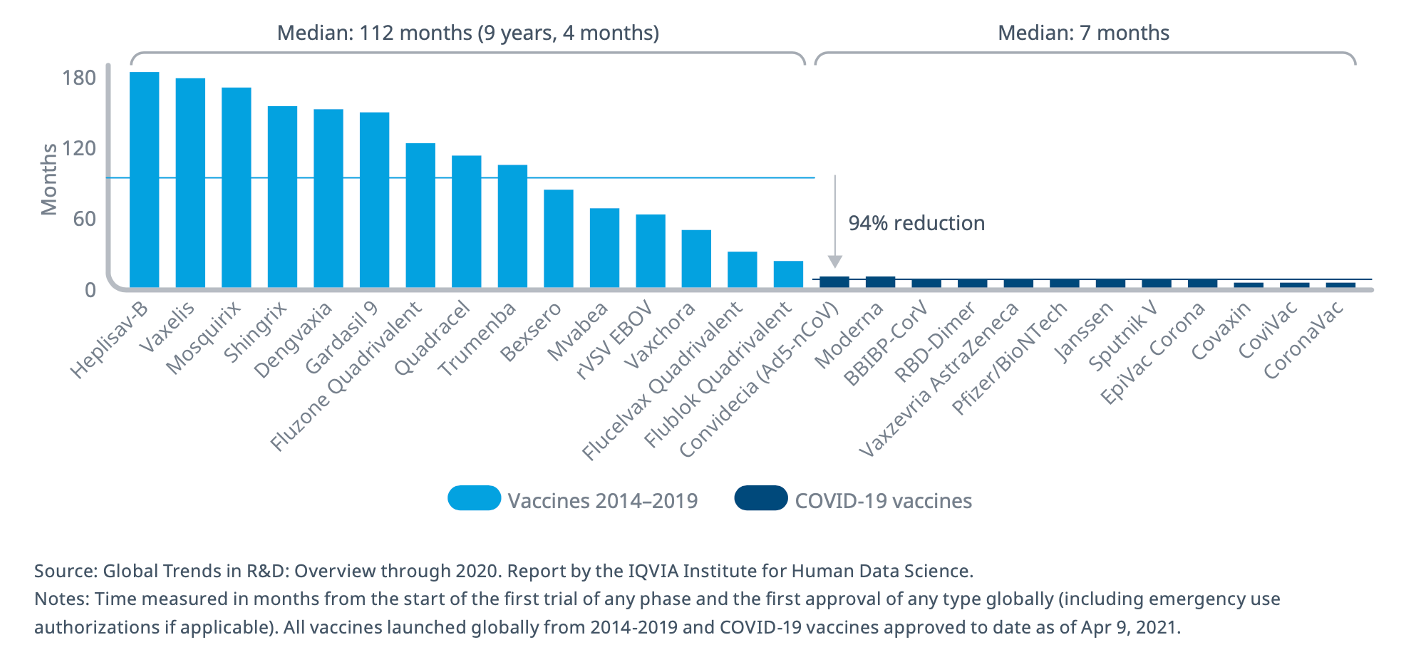
COVID-19 vaccine trial efficiencies were delivered via shifts in operational actions, organizational alignment, and delivery model drivers.
Characterization of how the COVID-19 vaccine trial level changes were achieved surfaced more than 20 critical and impactful changes that can be organized into a nested framework of operational actions, organizational alignment, and model drivers (see Figure 2 below).
Figure 2.
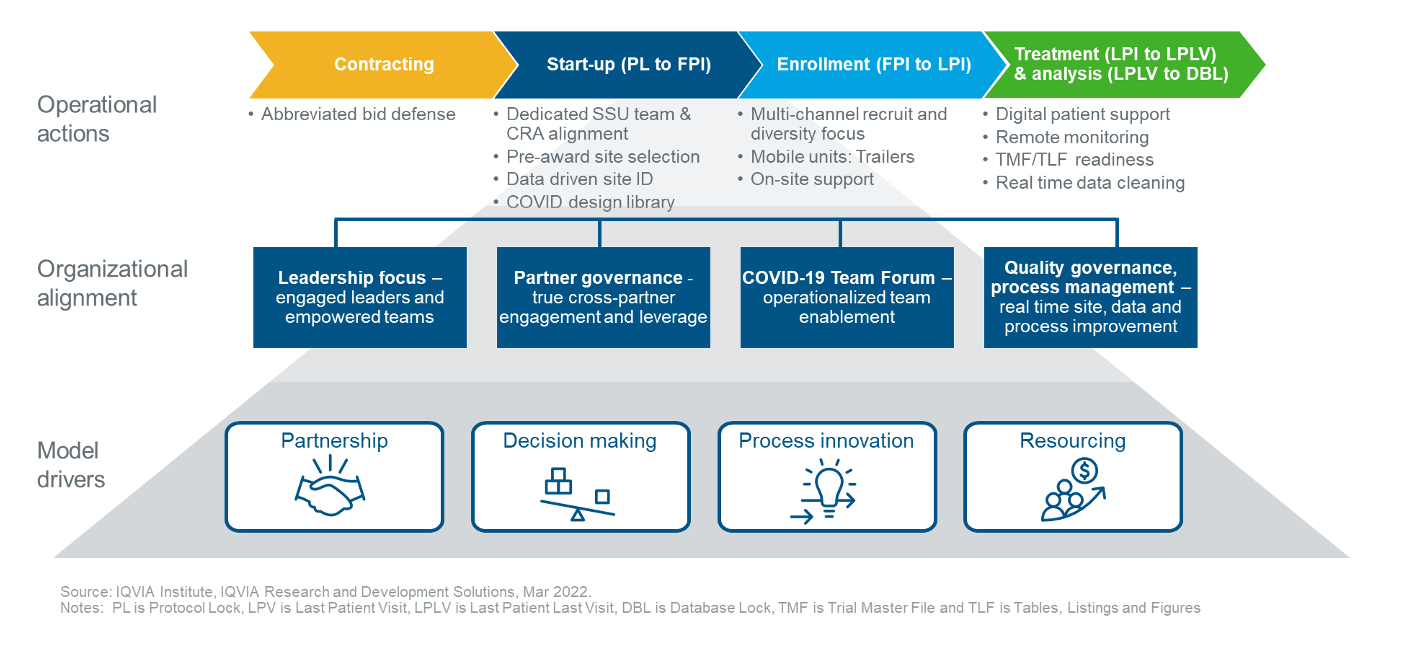
- Operational actions: New operational investments and rapid scaling of existing innovations led to significant trial efficiencies. These investments included capacity-building while scale-up efforts included decentralized trial infrastructure, novel site support strategies, digital patient support, and real- time data processing.
- Organizational alignment: Cross-functional and cross-organizational team and leadership alignment and organizational constructs were critical to the efficiencies delivered through the pandemic. These required a high level of focus and some specific resource investment in novel and existing organizational structures.
- Model drivers: Fundamental shifts in foundational behavioral and business model norms allowed for multiple, simultaneous operational and organizational changes to occur.
Operational actions
Time savings across the study contracting, study start-up, study participant enrollment, and database lock and analysis trial stages range from 44% for contracting to 94% for database lock and analysis. These time savings align to a set of functional and operational innovations and investments spread across the four key stages of vaccine clinical trial delivery (see Figure 3 below).
Figure 3. Overview of operational actions aligned to trial stage and impact
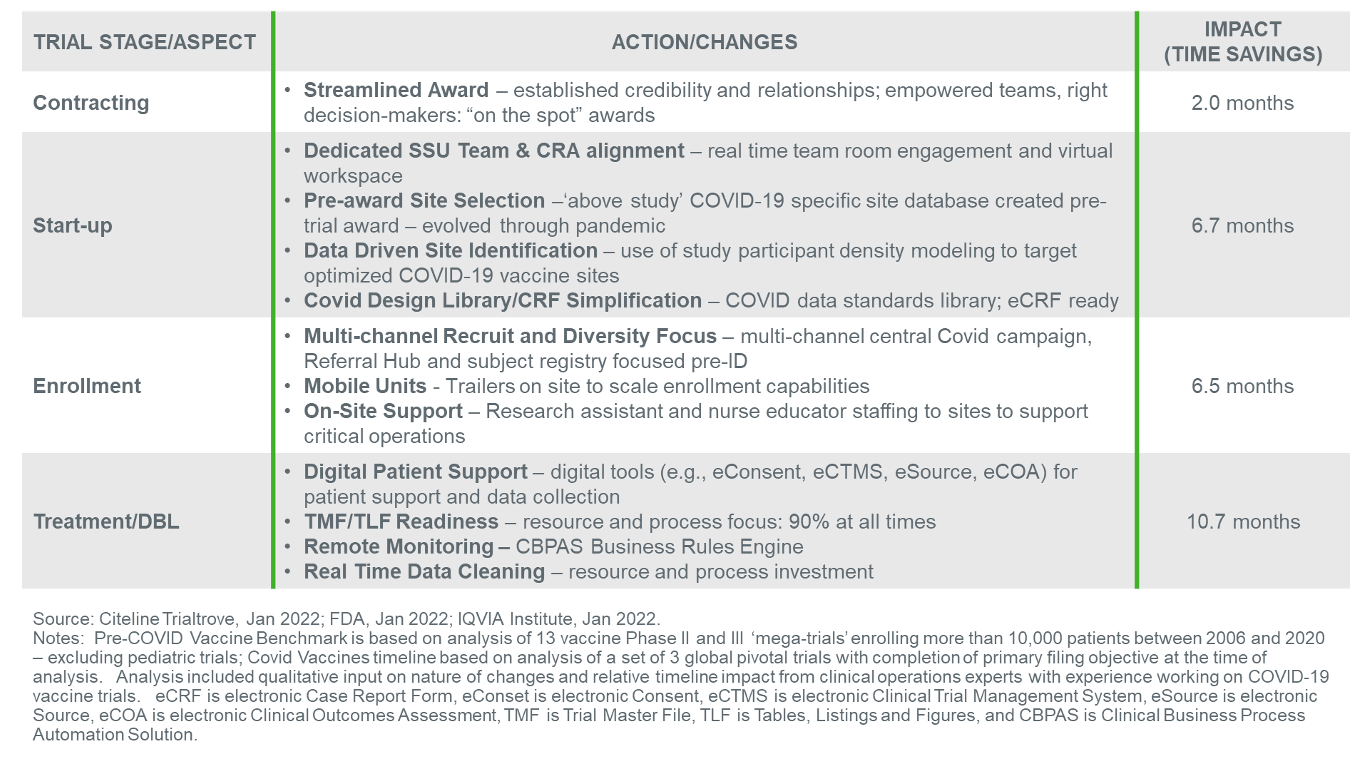
Organizational alignment
In addition to specific operational actions, teams pointed to organizational constructs that were necessary for the efficiencies achieved in these trials. These included highly engaged leadership connections and empowering teams to drive different ways of decision-making and operating, multi-layer partnership governance structures, a cross- trial working team forum enabling real-time operations, resource and process optimization and innovation, and finally, critical quality management processes and governance to support rapid process changes (see Figure 4 below).
Figure 4. Overview of critical organizational actions
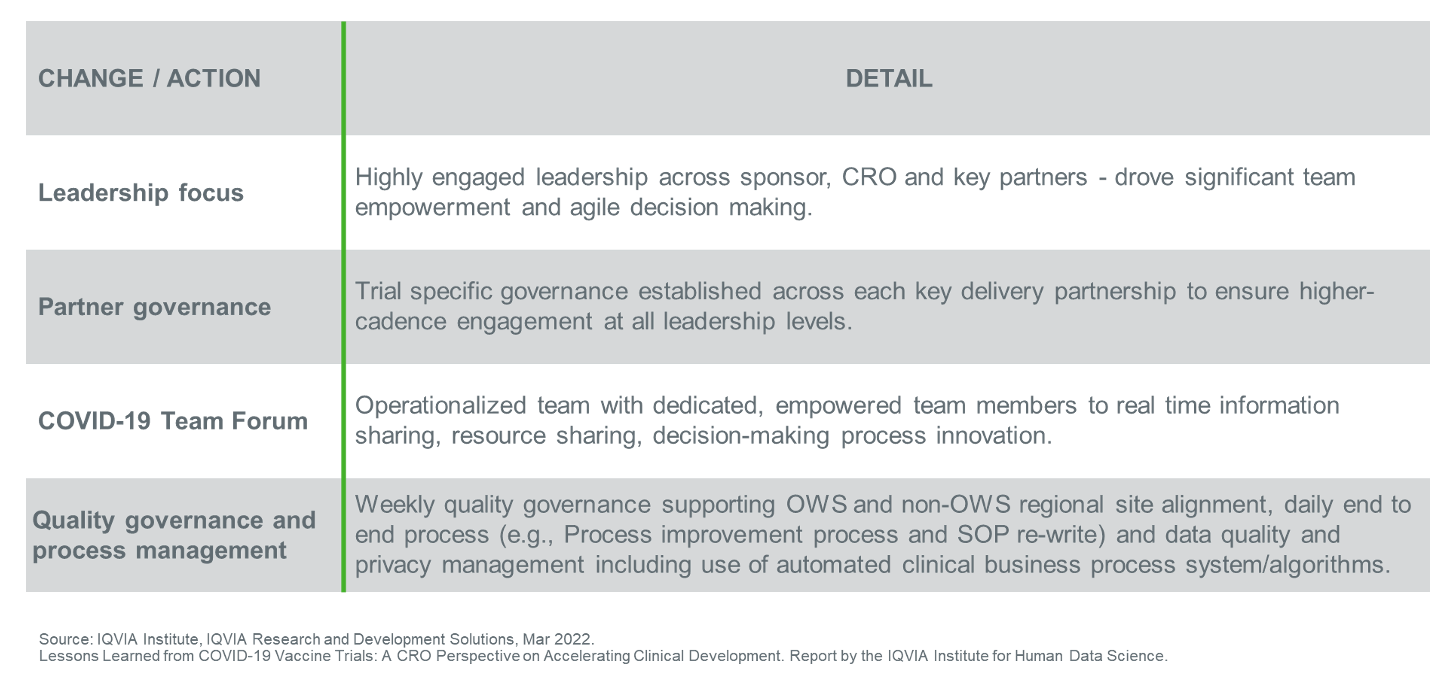
Model drivers
Complementing organizational alignment and enhanced leadership focus, four fundamental, interconnected themes underpinned all the operational and organizational efficiencies delivered on the COVID-vaccine trials: intensified partnership, significantly more agile and empowered decision-making, appetite and capacity for process innovation, and willingness for resource investment to drive faster timelines.
An analysis of the relative influence of these drivers on operational action time savings indicates that process innovation and resourcing were the largest efficiency contributors, aligning to 35% and 31% of time savings, respectively, though partnership dynamics and decision-making were also important, driving 19% and 15% of the time savings in turn (see Figure 5 below).
Figure 5. Relative impact of model drivers, % of time savings
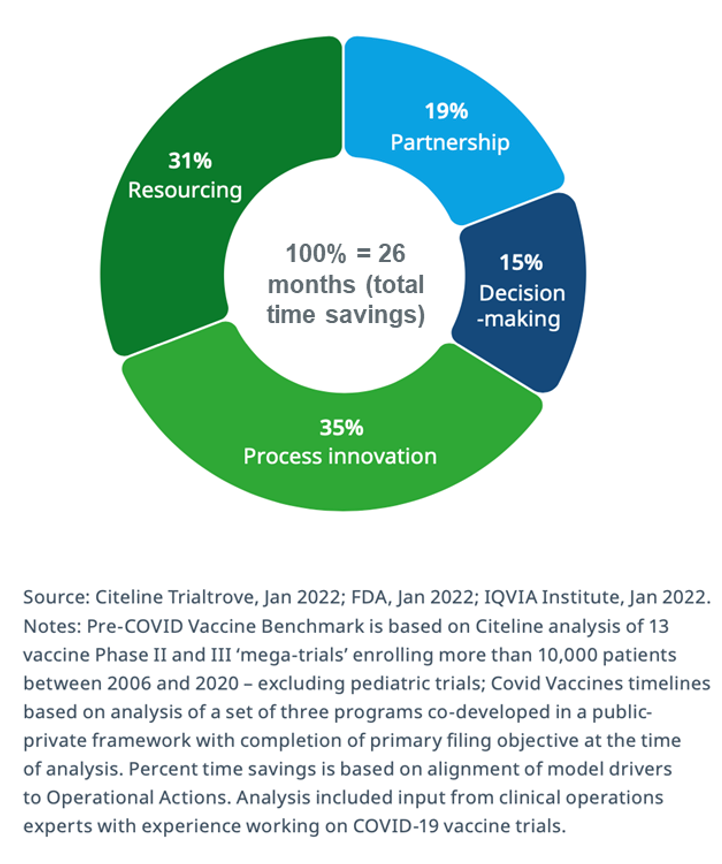
Top efficiencies and ongoing investments
Beyond the operational and organizational changes, the study looked at top efficiencies versus ongoing investments in trial innovations.
Comparison of COVID-19 vaccine trial resource utilization to pre-COVID-19 vaccine benchmarks confirmed that significant investment was made at the project, site, and study participant levels to deliver trials at the accelerated pace and across the analyzed set of trials.
Aligning relative resource investment to relative efficiency return allowed characterization of return on investment for COVID-19 vaccine development changes and highlights two investments categories: top efficiencies and ongoing investments.
Top efficiencies included data management, remote monitoring and multi-channel recruiting innovation investments that were underway when the pandemic hit and that scaled rapidly to deliver efficiency, as well as key organizational investments in leadership focus, partnership governance, and quality processes and governance.
Ongoing Investments included innovations around digital study participant enablement that were proven critical in delivering these trials, but which will still need further industry investment to deliver at scale, and solutions such as on-site support and mobile research units, which deliver timeline benefits through increased resource intensity.
High ROI improvements have the potential to impact most segments of the ongoing industry pipeline with thoughtful consideration of specific applicability—but will require focused investments to ensure that key innovations continue to mature, and external enablers of clinical development efficiency persist.
Actionable learnings for clinical operations—beyond vaccines
While many of these changes were precipitated by unique environmental enablers, many are repeatable outside the context of the pandemic and provide learnings for clinical operations beyond infectious diseases and vaccine development.
Here are some key actional learnings for clinical operations of general value:
Consider enabling environmental factors: While there were many important operational and organizational changes that accelerated the clinical development of COVID-19 vaccines and therapeutics, the impact from environmental factors can’t be underestimated as enabling drivers. In other disease areas, factors in the general environment can be positive enablers of clinical development by stimulating public awareness, generating additional fundings, motivating patient engagement in clinical trials, and fostering supportive stakeholder collaborations. This is relevant in the context of driving clinical development in areas with significant unmet needs, such as, hard-to-treat cancers, for example pancreatic cancer, or public health challenges such as Alzheimer’s disease and anti-microbial resistance.
Change the role of regulators: During COVID-19 vaccine trials, regulators in general changed their traditional role from operating as gatekeepers to enablers of efficiency. This was demonstrated in multiple ways: through rolling reviews, support for novel and innovative trial designs, and more flexibility in communications with industry sponsors. This shift from a reactive to a more proactive involvement of regulators in clinical trials will potentially generate significant value in other disease categories as it may help reduce waiting time and white space in the clinical development timelines.
Link clinical trial design and execution: One of the positive lessons about operational efficiency in the development of the COVID-19 vaccine trials was the linkage between clinical trial design and execution. Connecting clinical operations teams with design teams early in development was an important learning that can be applied in other therapeutic categories.
Address all trial inefficiencies simultaneously: Many of the inefficiencies in clinical trials that were overcome during COVID-19 vaccine development have been recognized previously, but they have typically been addressed in isolation. During the clinical development of solutions for the pandemic, these inefficiencies were tackled simultaneously as part of an integrated eco-system of change. This holistic approach was instrumental in reducing the white space in clinical development and can be applied with value across other therapeutic areas.
Enhance decision-making: Overall, sponsor company decision-making processes were disrupted and changed during COVID-19 vaccine trials. More efforts were devoted to planning and design early on to ensure the right decisions and resourcing of teams. There was also more flexibility in pushing decisions down to people at the bench-level while at the same time making sure that there was quick access to decisions at the senior level when required. Greater leadership focus and availability was also acknowledged as being critical to faster turnaround times.
Prioritize minority populations: During the vaccine trials, community engagement was pursued systematically to prioritize minority populations that were disproportionately affected by the COVID-19 pandemic. Utilizing social-behavioral approaches, efforts were made successfully to enroll Black, Hispanic, Native-American, older, and veteran populations in Phase III trials. Applying community engagement strategies will have potential impact on ensuring proportionate representation of minority populations in clinical trials.
Coordinate efforts between CROs and sponsor companies: One of the most fascinating aspects of the pandemic has been changes in the dynamic collaboration between contract research organizations (CROs) and sponsor companies. The clinical trial landscape is traditionally highly fragmented, with many players addressing specific tasks in the complex clinical trial process in isolation – sponsor companies, CROs, device and tech-providers, laboratories, etc. The pandemic has seen the dawn of new, more integrated, open, and agile models of collaboration that have contributed to acceleration of timelines. Such new models will hopefully be applied across clinical trials in other disease categories.
Despite the complexity of clinical trials and the specific challenges and needs across different therapeutic categories, COVID-19 vaccine trials have yielded very valuable lessons that can be turned into positive actionable learnings for clinical operations in general to help reduce white space in clinical development and shorten timelines.
Nicole Connelly, Research Director, IQVIA Institute for Human Data Science
Putting Collective Insights Into Action to Advance Cancer Care: Key Examples From ASCO 2025
June 27th 2025At ASCO 2025, clinical operations leaders gained critical insights into how AI tools, bispecific antibodies, and evolving treatment paradigms are reshaping trial design, endpoint selection, and patient stratification.
What Can ClinOps Learn from Pre-Clinical?
August 10th 2021Dr. Hanne Bak, Senior Vice President of Preclinical Manufacturing and Process Development at Regeneron speaks about her role at the company as well as their work with monoclonal antibodies, the regulatory side of manufacturing, and more.
2025 DIA Annual Meeting: Why AI and Automation Are Set to Become the New Normal in Clinical Research
June 20th 2025Peter Ronco, CEO, Emmes, shares his long-term vision for artificial intelligence in clinical research, from making automation routine to improving drug discovery, transforming regulatory oversight, reducing animal testing, and promoting ethical, equitable data use worldwide.